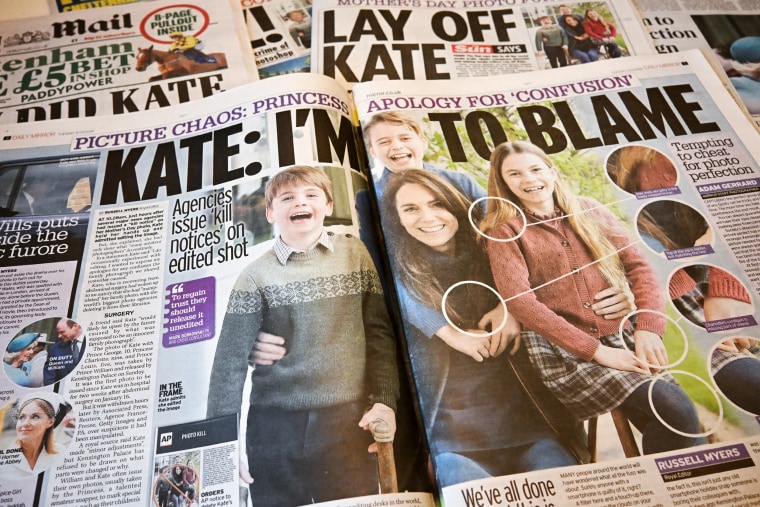Kate’s edited photo deepens the mistrust the palace hoped to quell
LONDON — Royal images have been manipulated since at least the 1590s when artists painted Queen Elizabeth I as a young woman despite her being more than 60 years old.
But the edited photo of Kate, the Princess of Wales, and her three children has stirred up a decidedly modern controversy as it has inflamed conspiracy theories about her whereabouts, while raising questions about the royal family’s role in constructing its own image and how, or whether, it can be trusted to do so.
After the revelations that the photo to mark Mother’s Day in Britain — the first public depiction of Prince William’s wife since December — had been manipulated, international news agencies pulled the image, making it clear they will no longer stand for even superficial edits when it comes to palace handouts. A mistrustful public began poring over every pixel for evidence of falsification.
Some media and royal experts say that this will stand as a pivotal event, after which the palace and perhaps other public figures will be far more cautious in terms of the images they distribute.
“If they didn’t know already, they will know now that they’re going to be held accountable — and quite rightly,” said Steven Barnett, a communications professor at London’s University of Westminster. “We’re talking about the heir to the throne. In British constitutional terms, King Charles I is the head of state, and his son is the heir to that state.”
“We know that pictures that have been put out before have always been edited — every single royal image going back decades,” said Roya Nikkhah, a royal correspondent with The Sunday Times. But this time, she added, “I think there’ll be lessons learned for the palace PR operation.”

The relationship between public figures, the press and the truth has never been a straightforward one. The range of fakery spans airbrushed cellulite in fashion magazines to Soviet officials being purged from official photographs after falling out of favor with Joseph Stalin.
That skepticism is only growing with the rise of artificial intelligence and improvements in cheap editing software, as well as the informational Wild West that is social media. It’s on these platforms that an ecosystem of conspiracy theories has been thriving, with self-appointed detectives analyzing every detail of the royals’ pictures for evidence of deception or subterfuge.
These corners of the internet will always exist. But after this week, Kate and William, the Prince of Wales, will be eager not to fall foul of the traditional media’s (not always infallible) rules on accuracy, Barnett said.
“Certainly William and Kate will be much more careful now, and their PR advisers will be much more careful about putting stuff out on their own accounts,” Barnett said. “They will want to make doubly sure that they’re not misleading people, whether it’s willful or whether it’s accidental.”
This also speaks to a latent tension between the royal family and the media. The royals often demand the same kind of privacy that might be afforded a regular family; the news media reminds them that they are, in fact, a deeply political public institution, one with vast influence and funded by around $110 million from taxpayers each year.
Before this weekend, the hashtag #WhereisKate was mainly a forum for tin foil hats and people making light-hearted memes about the regal soap opera. But the manipulated photo has given those theories mass market appeal, with aspiring influencers appointing themselves photoshop sleuths to carry out audits of everything released by the royal family.
One image in particular, showing Kate leaving her home in Windsor Castle, prompted some people to claim that the pattern of bricks in one part of the image did not match another.
Goff Photos, the agency that distributed the photo, said in a statement that “image has been cropped and lightened, nothing has been doctored.”
The thing that catapulted this week’s drama to a different level was the decision by four international news agencies to very publicly and pointedly retract the photo from their platforms.
“There’s a lot of distrust around journalism, sometimes with good reason, particularly given the reputation of the tabloid press in this country,” Barnett said. “But this incident reminds the rest of the world that there is a real value to journalists and journalism in being the gatekeepers of authenticity.”
Drawing a line in the sand on Kate’s photo was “good for all of us in terms of media literacy, and people understanding they should be perhaps skeptical of some of the things they see,” he added.
Not everyone is so optimistic…
Read More: Kate’s edited photo deepens the mistrust the palace hoped to quell

